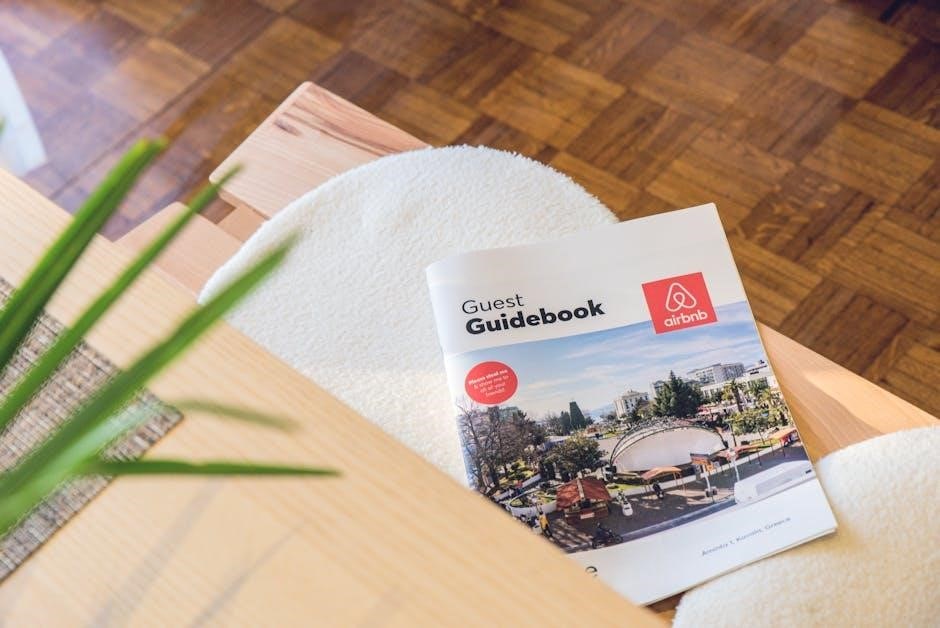S
imon Boas, a 46-year-old aid worker diagnosed with terminal cancer, authored A Beginner’s Guide to Dying, offering reflections on life, death, and living fully. His work resonates deeply.
1.1. Who is Simon Boas?
S
imon Boas, a 46-year-old charity worker from Jersey, gained recognition for his candid and uplifting perspective on life and death. Diagnosed with terminal cancer, he authored A Beginner’s Guide to Dying, a heartfelt reflection on his journey. Known for his optimism and resilience, Boas emphasizes living fully and finding gratitude in life’s moments. His work, including a widely shared newsletter, offers practical wisdom and emotional support, helping others navigate mortality with grace and clarity. His story resonates globally, inspiring conversations about life, loss, and legacy.
1.2. The Background and Inspiration Behind “A Beginner’s Guide to Dying”
S
imon Boas, facing a terminal cancer diagnosis at 46, channeled his experience into A Beginner’s Guide to Dying. As an aid worker, his career in helping others influenced his approach to mortality. The book, written in his final months, reflects his journey, blending practical advice with emotional insights. Inspired by his own struggles and acceptance, Boas aimed to demystify death, encouraging others to embrace life’s fragility. His work, born from personal loss, seeks to inspire gratitude and mindfulness, leaving a lasting legacy for those navigating life’s challenges.

The Concept of Death and Dying in Modern Society
Death remains a taboo topic in many cultures, often avoided due to fear or discomfort. Open conversations about mortality, however, can reduce fear and promote living fully.
2.1. Why Death is a Taboo Topic in Many Cultures
Death is often viewed as taboo due to fear, discomfort, and societal avoidance. Many cultures avoid discussing mortality, leading to anxiety and misunderstanding. This reluctance stems from the unknown, fear of loss, and the perception of death as an end rather than a natural part of life. Simon Boas’ work challenges this taboo, emphasizing the importance of open dialogue to reduce fear and foster acceptance. By addressing death openly, his approach encourages people to live more fully and meaningful lives. This perspective highlights the need to normalize conversations about mortality.
2.2. The Importance of Open Conversations About Mortality
Open conversations about mortality are essential for fostering understanding and acceptance. Discussing death openly reduces fear and stigma, allowing individuals to confront their own impermanence. Simon Boas emphasizes that these dialogues encourage people to live more mindfully and appreciate life’s value. By normalizing such discussions, society can help individuals and families prepare emotionally and practically for the inevitable. Openness about death also promotes gratitude, clarity, and meaningful connections, aligning with Boas’ message of living fully until the end. These conversations empower us to embrace life’s preciousness and find peace in its impermanence.

The Structure and Key Themes of the Book
A Beginner’s Guide to Dying is structured to guide readers through life’s final journey with compassion. Key themes include living fully, acceptance, and gratitude, offering a heartfelt message about life and death.
3.1. An Overview of the Book’s Chapters and Layout
A Beginner’s Guide to Dying is structured as a practical guidebook, blending personal reflections with actionable advice. The book is divided into clear, accessible chapters that explore themes such as understanding death, preparing for the end of life, and finding peace. Each section is designed to guide readers through difficult topics with empathy and clarity. The layout includes personal anecdotes, practical tips, and philosophical musings, making it both a emotional and educational resource. Appendices offer additional tools for planning and support, ensuring a comprehensive approach to this universal journey.
3.2. Central Themes: Living Fully, Acceptance, and Gratitude
A Beginner’s Guide to Dying explores three central themes: living fully, acceptance, and gratitude. Simon Boas emphasizes the importance of maximizing life’s potential, even in the face of death. Acceptance is portrayed as a liberating force, allowing individuals to embrace reality without resistance. Gratitude emerges as a powerful tool for finding peace and contentment, encouraging readers to cherish life’s small joys. These themes intertwine to create a holistic approach to mortality, offering readers a path to emotional and spiritual fulfillment during life’s final stages.

Practical Advice for Beginners
Simon Boas offers practical advice on approaching death, encouraging readers to start small, seek support, and focus on what truly matters in life.
4.1. How to Approach the Topic of Death
Simon Boas emphasizes the importance of approaching death with honesty and openness. He suggests starting small, sharing feelings with trusted individuals, and gradually building comfort. Boas recommends normalizing death conversations by integrating them into everyday life, fostering a culture of acceptance. His advice encourages readers to embrace vulnerability and seek support, highlighting that discussing death is an act of love and courage. By addressing mortality directly, individuals can live more authentically and fully, aligning with Boas’ philosophy of cherishing life while acknowledging its impermanence;
4.2. Building a Support Network and Seeking Help
Simon Boas highlights the importance of surrounding oneself with a supportive community when facing death. He encourages reaching out to family, friends, and support groups to share emotions and experiences. Boas also emphasizes the value of professional guidance, such as therapy or counseling, to navigate complex feelings. Building a network fosters connection and reduces isolation, allowing individuals to lean on others during difficult times. By seeking help, one can gain strength, perspective, and a deeper understanding of their journey, aligning with Boas’ belief in the power of community and openness.

Simon Boas’ Personal Journey with Terminal Cancer
S
imon Boas, diagnosed with terminal cancer at 46, embarked on a profound journey of acceptance and reflection. His experiences shaped his book, offering insights into mortality.
5.1. Diagnosis and the Initial Reaction
S
imon Boas, at just 46 years old, received the life-altering diagnosis of terminal cancer. The news instilled shock and grief, forcing him to confront his mortality head-on. Despite the overwhelming emotions, he embraced a determined mindset, choosing to approach his remaining time with optimism and purpose. His reflections during this period became the cornerstone of his book, offering raw honesty and profound insights into the human experience of facing death with courage and grace.
5.2. The Emotional and Psychological Impact
S
imon Boas faced profound emotional and psychological challenges following his terminal cancer diagnosis. The initial shock gave way to grief, denial, and fear about leaving loved ones behind. However, he gradually shifted toward acceptance, embracing the reality of his situation. This journey of emotional processing deeply influenced his writing, as he sought to normalize death and encourage others to confront mortality with courage. His reflections reveal a man who, despite immense pain, found peace and purpose in sharing his experiences.
The Role of Mindset and Positivity
S
imon Boas’ optimistic mindset transformed his approach to terminal cancer, emphasizing positivity as a powerful tool for living fully and inspiring others to embrace life’s beauty.
6.1. The Power of Optimism in the Face of Adversity
S
imon Boas exemplified the transformational power of optimism, even in the face of terminal cancer. His diagnosis at 46 could have shattered his spirit, but instead, it fueled his resilience. Boas believed that maintaining a positive outlook was not about ignoring the reality of death but about embracing life’s beauty. He emphasized that optimism is a mindset, a choice to focus on what truly matters. By prioritizing love, gratitude, and joy, he inspired countless readers to reframe adversity as an opportunity for growth. His unwavering positivity left an enduring legacy.
6.2. How to Cultivate a Positive Mindset
S
imon Boas believed that cultivating a positive mindset begins with small, intentional practices. He emphasized the importance of gratitude, focusing on what truly matters, and surrounding oneself with supportive loved ones. By shifting perspective to appreciate life’s simple joys, individuals can foster resilience. Boas also highlighted the value of acceptance, not as resignation but as a path to peace. His approach encouraged readers to embrace the present and find meaning in everyday moments, transforming adversity into opportunities for growth and connection. His teachings continue to inspire a mindset of hope and joy.
Lessons for Living a Fulfilling Life
S
imon Boas’ work emphasizes prioritizing what truly matters, cherishing moments, and embracing life’s impermanence. His insights encourage living intentionally, fostering meaningful connections, and finding purpose in every day.
7.1. Prioritizing What Truly Matters
In his reflections, Simon Boas underscores the importance of identifying and focusing on life’s true priorities. He emphasizes that death’s proximity clarifies what truly matters—relationships, gratitude, and living intentionally. By sharing his journey, he encourages readers to reassess their values and align their actions with what brings fulfillment. His insights highlight the transformative power of prioritizing meaningful connections and experiences over material pursuits, offering a timeless lesson in living authentically and fully, even in the face of mortality.
7.2. Embracing Impermanence and Letting Go
S
imon Boas’ work profoundly explores the acceptance of life’s impermanence, encouraging readers to embrace change and release attachments. His terminal diagnosis became a catalyst for this realization, teaching him to cherish moments rather than cling to material possessions or fears. By letting go of what no longer serves, he found peace and clarity. His insights remind us that impermanence is life’s natural rhythm, and embracing it allows us to live more fully and meaningfully, even in the face of uncertainty. This mindset fosters gratitude and a deeper appreciation for life’s fleeting beauty.

The Impact of “A Beginner’s Guide to Dying”
S
imon Boas’ book has become a Sunday Times Bestseller, resonating deeply with readers worldwide. Its heartfelt message has inspired countless individuals to confront mortality and live more fully.
8.1. Reader Responses and Reviews
Readers worldwide have embraced Simon Boas’ A Beginner’s Guide to Dying, praising its heartfelt honesty and life-affirming message. Many describe the book as a “must-read,” offering comfort and perspective to those facing loss or seeking to live more meaningfully. Reviewers highlight its practical advice and emotional depth, with one calling it an “inspirational paean to the joy of life.” The book’s relatable tone has created a sense of connection, resonating deeply with audiences and fostering meaningful conversations about mortality and living fully.
8.2. The Book’s Contribution to the Conversation About Death
A Beginner’s Guide to Dying has significantly contributed to normalizing conversations about death, offering a compassionate and practical perspective. By sharing his personal journey, Simon Boas encourages readers to confront their fears and embrace life’s impermanence. The book’s approachable tone and heartfelt wisdom have sparked meaningful discussions, helping to dismantle the taboo surrounding mortality. It reminds us that death is not just an end but also a reminder to cherish life’s beauty and significance, fostering a cultural shift toward openness and acceptance of this universal experience.

Final Thoughts and Legacy
Simon Boas’ final thoughts inspire a life of gratitude and acceptance. His legacy transforms death discussions, urging us to embrace life’s beauty fully and meaningfully always.
9.1. Simon Boas’ Lasting Message
Simon Boas’ enduring message emphasizes accepting death’s inevitability while living fully. He encourages embracing gratitude, prioritizing meaningful connections, and finding peace in life’s impermanence. His reflections, shared through A Beginner’s Guide to Dying, inspire readers to confront mortality with courage and optimism. Boas’ words transcend his personal journey, offering universal wisdom on cherishing life and facing death with grace. His legacy lies in transforming fear into acceptance, fostering a deeper appreciation for life’s preciousness. His message continues to resonate, guiding others to re-evaluate their priorities and embrace life’s beauty fully.
9.2. How His Work Continues to Inspire Others
A Beginner’s Guide to Dying has become a catalyst for meaningful conversations about life and death. Readers worldwide have found comfort in Simon Boas’ practical advice and emotional honesty, transforming their perspectives on mortality. His words resonate deeply, encouraging others to live mindfully and cherish relationships. The book has also fostered an online community where people share their experiences and support one another. Boas’ legacy continues to inspire others to embrace life’s fragility with gratitude and courage, creating a lasting impact on how people approach death and living fully. His work remains a powerful source of comfort and guidance.
